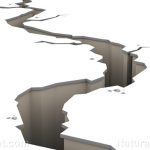
Deciphering earthquake patterns: Scientists examining sediment cores determine large quakes are not as random as previously thought
Saturday, September 15, 2018 by David Williams
http://www.realsciencenews.com/2018-09-15-scientists-sediment-cores-earthquakes-not-random.html

Earthquakes can be devastating primarily because of two things: first, they tend to have massively destructive power; and second, they are largely unpredictable. Indeed, because of the seemingly random occurrences of most earthquakes, they usually leave behind huge amounts of destruction. Now a new team of researchers has gathered data to prove that, despite all of the common knowledge on them, earthquakes may not be so random after all.
According to an international team of researchers which includes experts from Belgium, Chile, and Switzerland, giant earthquakes in particular tend to reoccur at relatively regular intervals. It’s only with smaller earthquakes that the regular occurrence becomes rarer, and where they appear to happen randomly in time. The details of the study conducted by the researchers were published in a recent paper in the journal Earth and Planetary Science Letters.
The researchers noted that the scientific community doesn’t have a clear consensus on the regular or seemingly random occurrences of most earthquakes.
“It is an ongoing topic of very vivid debate whether we should model large earthquake recurrence as quasi-regular or random process in time,” said Jasper Moernaut, an assistant professor at the University of Innsbruck, Austria, and lead author of the study. “Of course, the model choice has very large repercussions on how we evaluate the actual seismic hazard in Chile for the coming decades to centuries.”
Indeed, knowing whether or not earthquakes regularly occur at certain intervals or not can be instrumental in keeping a record of when they occur and what happens afterward. It is as Moernaut points out in saying that understanding when and where such devastating giant earthquakes may occur in the future is a crucial task for the community of geoscientific researchers and experts.
To this end, the researchers analyzed the sediment cores found from Chilean lakes, where the largest known quake ever to occur on Earth was recorded, with a magnitude of 9.5. The resulting tsunami from this particular giant earthquake was said to be so massive that it went all the way to Japan and ended up killing 200 people living there. The researchers found that they could gather very important data based on the sediments found on the bottom of the lakes where this earthquake occurred.
According to the researchers, they were able to sample layers of the sedimentary rocks in up to eight-meter long cores, and from these, they managed to retrieve the complete earthquake history over the last 5,000 years. They even uncovered up to 35 different earthquakes with magnitudes of 7.7 or higher based on these “records.”
The data gathered by the researchers showed that giant earthquakes tend to reoccur every 292 ± 93 years, which means that the probability of yet another one occurring in the next 50 to 100 years is very low. However, smaller earthquakes took place more randomly and that one may occur in the next 50 years, at least.
Moernaut praised the Chilean lakes, and their sedimentary layers at the bottom in particular, for offering such a fantastic opportunity to study earthquake recurrence. For now, similar studies on other lakes are already being conducted to find out what kind of information they can bring.
Marc De Batist from Ghent University, who also worked on the study, said: “We are looking forward to some exciting comparisons between data from these settings, and see if the Chilean patterns hold for other areas that have experience giant earthquakes in the past.”
For more stories about natural disasters, visit Disaster.news today.
Sources include:
Tagged Under: Tags: Chile, discoveries, Earth Changes, Earthquakes, geology, goodscience, natural disasters, predicting earthquakes, real science, research, tsunami





